
Radar Scope is a 1980 shoot 'em up arcade game developed by Nintendo R&D2 and published by Nintendo. The player assumes the role of the Sonic Spaceport starship and must wipe out formations of an enemy race known as the Gamma Raiders before they destroy the player's space station. Gameplay is similar to Space Invaders and Galaxian, but viewed from a three-dimensional third-person perspective.

River City Ransom, known as Street Gangs in PAL regions, is an open world beat 'em up video game originally for the Nintendo Entertainment System. It is an English localization of Downtown Nekketsu Monogatari for the Famicom. The game was developed by Technōs Japan and released in Japan on April 25, 1989.

Masayuki Uemura was a Japanese engineer, video game producer, and professor. He was known for his work as an employee of Nintendo from 1971 to 2004, most notably for serving as a key factor in the development of the Nintendo Entertainment System.

Arc System Works Co., Ltd., commonly referred to as ArcSys, is a Japanese video game developer and publisher located in Yokohama. Founded by Minoru Kidooka in 1988, the company is known for arcade 2D fighting game franchises, including Guilty Gear and BlazBlue, as well as other license-based fighting games for Dragon Ball FighterZ, Persona 4 Arena (Ultimax), Granblue Fantasy Versus (Rising), and others.
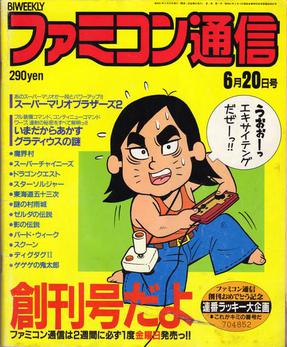
Famitsu, formerly Famicom Tsūshin, is a line of Japanese video game magazines published by Kadokawa Game Linkage, a subsidiary of Kadokawa. Famitsu is published in both weekly and monthly formats as well as in the form of special topical issues devoted to only one console, video game company, or other theme. Shūkan Famitsū, the original Famitsu publication, is considered the most widely read and respected video game news magazine in Japan. From October 28, 2011, the company began releasing the digital version of the magazine exclusively on BookWalker weekly.

Recca is a 1992 scrolling shooter video game developed by KID and published by Naxat Soft for the Family Computer. Controlling the titular space fighter craft, the player is sent to counterattack an invading alien armada while avoiding collision with their projectiles and other obstacles. The ship has a powerful bomb at its disposal that can be used as shield and clear the screen of enemies and bullets when fully charged.
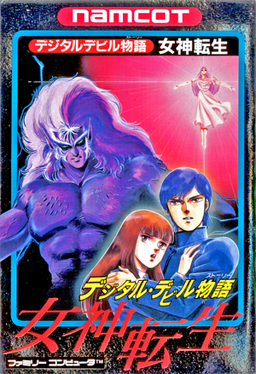
Digital Devil Story: Megami Tensei refers to two distinct role-playing video games based on a trilogy of science fantasy novels by Japanese author Aya Nishitani. One version was developed by Atlus and published by Namco in 1987 for the Famicom—Atlus would go on to create further games in the Megami Tensei franchise. A separate version for personal computers was developed and published by Telenet Japan with assistance from Atlus during the same year.

Family BASIC is a consumer product for programming on the Nintendo Family Computer, the Japanese equivalent to the Nintendo Entertainment System. Family BASIC was launched on June 21, 1984, to consumers in Japan by Nintendo, in cooperation with Hudson Soft and Sharp Corporation. A second version titled Family BASIC V3 was released on February 21, 1985, with greater memory and new features.

Famicom Wars is a wargame developed by Nintendo and Intelligent Systems and published by Nintendo for the Famicom. It was released on August 12, 1988 in Japan. It was later re-released on Virtual Console. It is the first game in the Wars series.

Yoshio Sakamoto is a Japanese video game designer, director, and producer. He has worked at Nintendo since 1982. He has directed several games in the Metroid series. He is one of the most prominent members of Nintendo's former Research and Development 1 division, along with Gunpei Yokoi and Toru Osawa.

Family Stadium, also known as Pro Yakyū: Family Stadium and Famista, is a series of baseball sports video games initially developed and released by Namco in Japan, and later developed and published by Bandai Namco Entertainment. The first entry in the series, Pro Baseball: Family Stadium, was released for the Nintendo Family Computer in 1986 and later in North America as R.B.I. Baseball, with the series being released on numerous home consoles, the latest being Pro Yakyuu Famista 2020 in 2020 for the Nintendo Switch. The series is considered a precursor to Namco's own World Stadium series of baseball games, released for arcades, PlayStation, and GameCube. The series has been a commercial success since, with over 15 million copies being sold as of 2016.

Famicom Mukashibanashi: Shin Onigashima, often simply referred to as Shin Onigashima, is an adventure game developed by Nintendo R&D4 and Pax Softnica and published by Nintendo. It was first released on two disk cards for the Family Computer Disk System. The first disk was released on September 4, 1987, while the second disk was released September 30. The driving force behind the series, Tatsuya Hishida of Nintendo EAD, was responsible for directing the game, creating the characters, and crafting the storyline.
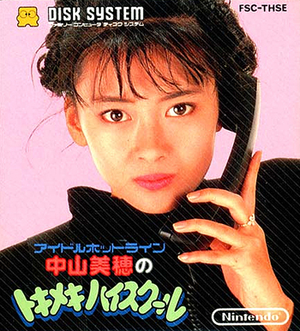
Nakayama Miho no Tokimeki High School is a 1987 dating sim developed by Square and Nintendo R&D1, and published by Nintendo exclusively in Japan for the Famicom Disk System. The game was released on December 1, 1987. It was one of the first dating sim games. It was designed by Hironobu Sakaguchi, who also created the Final Fantasy series, and Yoshio Sakamoto, who co-created Metroid. The music for the game was composed by Nobuo Uematsu and Toshiaki Imai. Pop idol Miho Nakayama contributed her name and likeness and voice-acted tie-in segments that could be accessed by calling toll-free phone numbers revealed during the progress of gameplay.
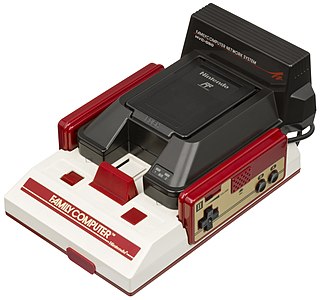
The Family Computer Network System, also known as the Famicom Net System and Famicom Modem, is a peripheral for Nintendo's Family Computer video game console, and was released in September 1988 only in Japan. Predating the modern Internet, its proprietary dial-up information service accessed live stock trades, video game cheats, jokes, weather forecasts, betting on horse racing, and a small amount of downloadable content. The device uses a ROM card storage format, reminiscent to the HuCard for the TurboGrafx-16 and the Sega Card for the Master System.

The Nintendo Entertainment System (NES) is an 8-bit third-generation home video game console produced by Nintendo. It was first released in Japan in 1983 as the Family Computer (FC), commonly referred to as Famicom. It was redesigned to become the NES, which was released in American test markets on October 18, 1985, and was soon fully launched in North America and other regions.
indieszero Corporation, Ltd. is a small video game development company headquartered in Musashino, Tokyo, Japan. It was founded on April 21, 1997, and has developed video games for other video game companies, including Nintendo, SEGA, and Square Enix.
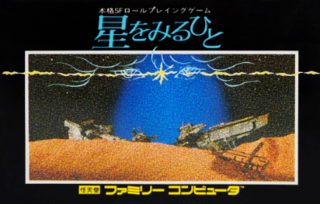
Hoshi wo Miru Hito is a 1987 Japanese video game for the Famicom home console. Developed by Another and published by HOT-B, it is based on the 1984 video game Psychic City. The game is a science fiction RPG where players use psychic powers to fight enemies.

The Nintendo Entertainment System (NES), an 8-bit third-generation home video game console produced by Nintendo, had numerous model variants produced throughout its lifetime. It was originally released in 1983 as the Family Computer in Japan, with design work led by Masayuki Uemura. Nintendo intentionally redesigned it as the NES in North America in an attempt to avoid the stigma of video game consoles lingering from the video game crash the same year; while it was initially conceptualized as a home computer, it was ultimately modeled after a videocassette recorder (VCR) for its debut there in 1985. Nintendo subsequently exported the NES to Europe and Oceania via local distributors.



















